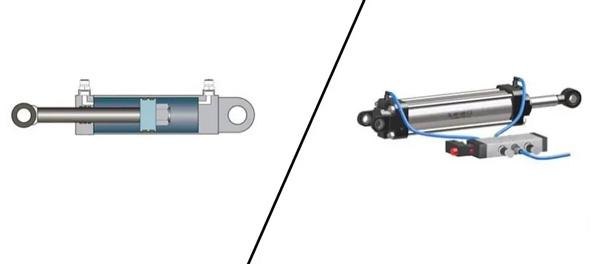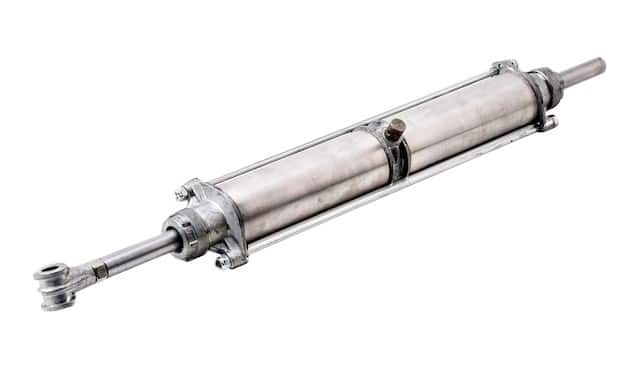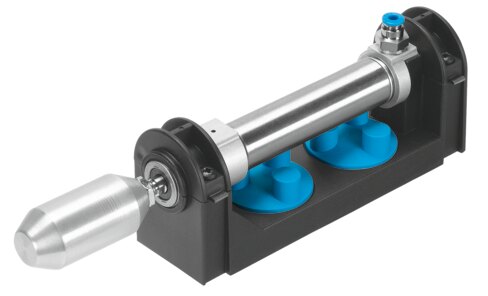Nov 11, 2025
Double-acting and single-acting are the two main actuation types of pneumatic cylinders.The difference lies in how the driving medium pushes the piston to move.
A double-acting cylinder has both pneumatic and hydraulic types,and a double-acting pneumatic cylinder is a pneumatic actuator that allows the piston to move back and forth in both directions through the action of a fluid medium. Compressed air alternately enters both sides of the piston, enabling bidirectional motion — extension and retraction — under air pressure.In contrast, a single-acting cylinder uses compressed air from only one inlet port to drive the piston in a single direction, while the return stroke relies on a spring or external force rather than air pressure.
◆ Bidirectional Motion:
The most distinctive feature of a Double Acting Cylinder is that its piston can move the load in both directions.
◆ Higher Output Force:
Since a Double Acting Cylinder has no internal spring structure, both the extension and retraction of the piston rod are driven by compressed air. As a result, this type of cylinder can handle heavier loads.
◆ Versatile Expandability:
Various functional components and accessories can be mounted on the outer surface of the cylinder barrel, including fixtures for mounting, stroke sensors, cushioning adjusters, and position feedback devices.
◆ More Precise Control of Speed and Stroke:
Because both ends of the piston are powered by compressed air, the movement of the piston rod can be controlled precisely in both directions.
◆ Automated Production Lines:
Pneumatic double acting cylinders can be rapidly driven by air pressure from both directions, enabling quick pushing and pulling actions.
◆ Packaging and Printing Machinery:
In packaging and printing processes that require box pushing, sealing, or roller adjustment, the bidirectional motion of the cylinder allows smooth extension and retraction, ensuring stable operation.
◆ Machine Tools and Pressing Fixtures:
In machine tool fixtures and press-fitting equipment, double acting cylinders can provide consistent clamping and releasing force in both directions.
Hydraulic double acting cylinders are suitable for heavy-duty pressing and high-precision tooling control.
◆ Conveying and Sorting Systems:
In conveyor lines and sorting machines, pneumatic double acting cylinders use their bidirectional drive to achieve reciprocating positioning and switching of materials.
◆ Hydraulic Presses and Injection Molding Machines:
Hydraulic double acting cylinders, driven by high-pressure oil, enable powerful and stable bidirectional piston motion, delivering the strong force required for heavy industrial machinery.
A double-acting cylinder typically includes:
Cylinder tube: A cylindrical chamber that houses the piston.
Piston: Moves back and forth inside the cylinder.
Piston rod: Connects to the piston and transmits force to the load.
Two ports (Port A and Port B): Connected to compressed air lines, used to drive the piston in different directions.
Seals: Prevent air leakage.
The key feature of a double-acting cylinder is that compressed air can drive the piston both forward and backward. Unlike a single-acting cylinder, which usually relies on a spring or external force for return.
A actuator double action cylinder achieves reciprocating motion by controlling which chamber the air enters.
Front chamber: The side of the cylinder where the piston rod exits.
Rear chamber (Rod Side): The opposite side of the piston rod, usually slightly smaller in volume than the front chamber.
Forward Stroke
Compressed air enters the front chamber through Port A, pushing the piston toward the rod side.
At the same time, air in the rear chamber is exhausted through Port B.
The piston rod extends, performing work on the load.
Return Stroke
Compressed air enters the rear chamber through Port B, pushing the piston backward.
Air in the front chamber is exhausted through Port A.
The piston rod retracts.
By controlling the air supply and using a directional control valve, the piston can perform precise reciprocating motions.
Single acting advantegs
Simpler structure;
lower air consumption
Disadvantegs
output force is limited by the spring's counterforce and therefore smaller;
return speed of the piston rod cannot be adjusted;
shorter service life and requires frequent maintenance.
Double acting advantages
High-frequency opening and closing with bidirectional control;
greater output force with balanced extension and retraction;
bidirectional speed adjustable via airflow;
longer service life with less frequent maintenance;
lighter and more compact in size and weight.
Disadvantegs
slightly more complex structure;
higher air consumption;
cannot automatically return when air supply is cut off, external measures required.

You May Interest In

Nov 12, 2025 Blog
What is a single acting cylinder?
Nov 06, 2025 Blog
Why choose a single acting pneumatic cylinder?

Links: www.fescolo.com(Pneumatic)
FOKCA ©1998-2025 All Rights Reserved Sitemap